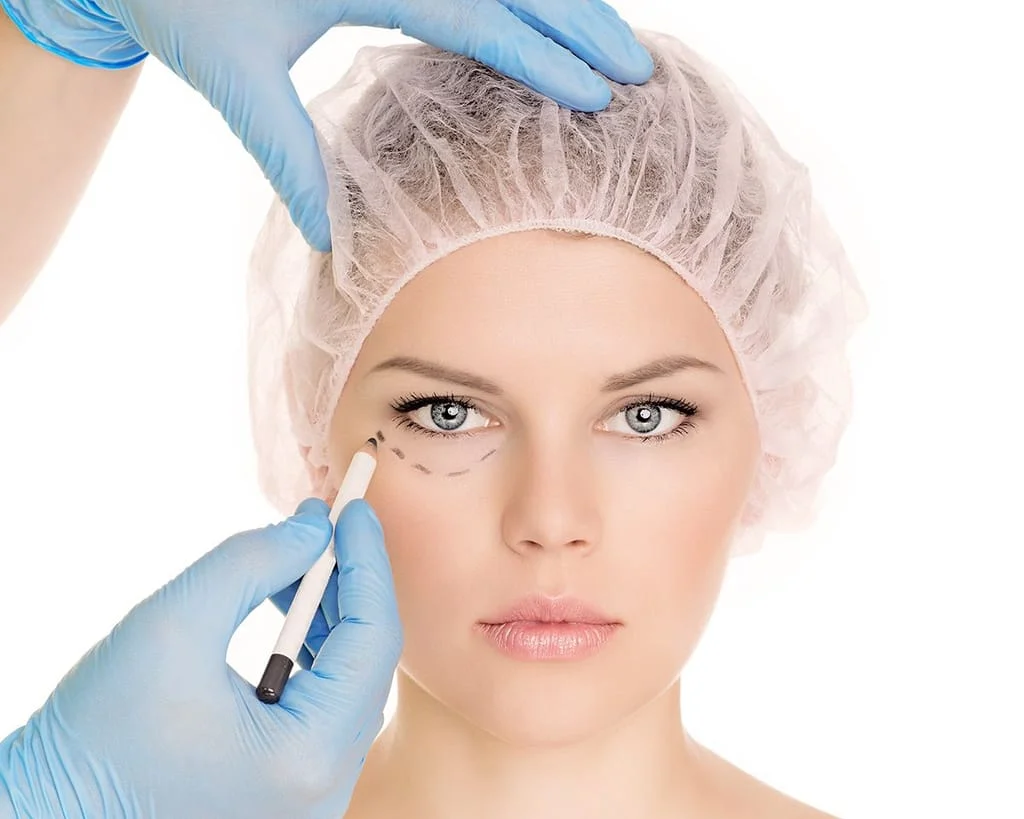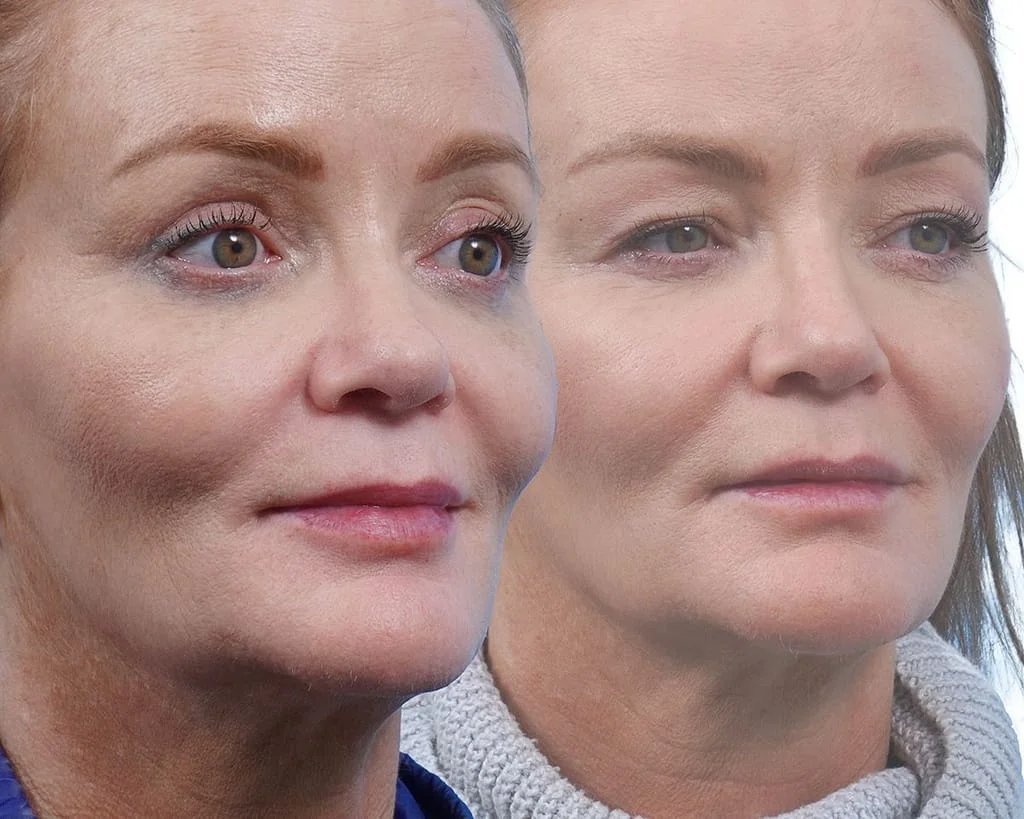Utah’s Leading Eyelid Lift Surgeons
Do you struggle with sagging or drooping eyelids that make you look tired or older than you feel? An eyelid lift could be the solution you've been searching for! Also known as blepharoplasty, this innovative cosmetic procedure is designed to remove excess skin and fat from the upper or lower eyelids, resulting in a more youthful, refreshed appearance that looks and feels natural. Whether you're dealing with bags under the eyes, puffiness, or other common signs of aging around the eyes, an eyelid lift offers a safe, effective, and long-lasting solution that can dramatically improve your overall appearance and boost your self-confidence.
What is an Eyelid Lift?
Functional Eyelid Lift
As we age, the brow and eyelids begin to descend and can obscure vision. In cases where the peripheral vision is restricted due to excess upper eyelid skin and descent of the brow, insurance will pay for the procedure to remove the excess skin and elevate the brow.

Who Is An Ideal Candidate For an Eyelid Lift?
A good candidate for blepharoplasty treatment would be someone who is generally healthy and has realistic expectations for the outcome of the procedure. They should be bothered by the appearance of droopy or puffy eyelids and understand that blepharoplasty can help to address these concerns, but will not necessarily create a completely new look. Age is not necessarily a factor, as both younger and older individuals can benefit from this procedure. However, individuals who have certain medical conditions or take medications that could affect healing may not be good candidates for blepharoplasty. It is important for candidates to discuss their medical history and any medications they are taking with their surgeon prior to the procedure to determine if they are a good candidate for blepharoplasty.
Eyelid Lift Procedure
The procedure may be done under sedation or even under local anesthesia and takes less than an hour to complete. The incisions are hidden in the natural-occurring eyelid crease and possibly behind the hairline, if a brow lift is needed. The methods used for a particular individual depends on that individual’s needs.
Recovery Process
If you had general anesthesia, you may to feel groggy for 24-48 hours following surgery. During this time, you may also experience nausea and infrequent vomiting. You will be prescribed some anti-nausea medication to help alleviate your symptoms. If vomiting becomes a significant problem, please get in touch with our office.
You may notice aches and discomfort throughout your body after surgery. Mild pain can be expected, but if your pain escalates and becomes severe, please contact our office immediately.
You will be swollen after surgery. It can be quite noticeable for the first 7-14 days after surgery.
Contact lenses should not be worn for two weeks following surgery. Occasionally, mild changes in vision can occur as a result of swelling. These changes will resolve as swelling decreases. We recommend not changing your eyeglass or contact prescription for two to three months following surgery.
You may experience temporary eye dryness after surgery, which can be treated with OTC artificial tears products.
Family members should not be alarmed if the whites of your eyes are slightly visible after surgery while you are sleeping. In order to achieve the best cosmetic result from upper eyelid surgery, the maximum amount of excess skin will be removed. Often, this will cause a temporary shrinkage of the upper eyelids, which does not allow the eyelid to close completely during sleep. As long as there is no associated pain or burning, this issue will resolve spontaneously.

EYELID LIFT RESULTS
Patients can expect a significant improvement in the appearance of their eyes after undergoing this procedure. However, the extent of the results can vary depending on the individual case. The final results of the procedure can usually be seen within several weeks to a few months after the surgery. It is important to follow the aftercare instructions provided by the surgeon to ensure proper healing and to achieve the best possible results. Most patients require only one blepharoplasty procedure to achieve their desired results, although some may require additional treatments depending on the severity of their condition or the extent of their desired improvements. A follow-up appointment will typically be scheduled with the surgeon to monitor the healing process and to ensure that the patient is satisfied with the results. Overall, blepharoplasty can provide patients with a rejuvenated and refreshed appearance that can boost their self-confidence and improve their overall quality of life.
TESTIMONIALS

EYELID Lift FAQ
After blepharoplasty (eyelid lift) surgery, it is important to follow your surgeon's post-operative instructions for a smooth recovery and optimal results. While the specific restrictions may vary depending on your individual case, here are some general guidelines:
Rest and avoid strenuous activities: You should plan to rest and limit physical exertion for the first few days after surgery. Avoid activities that may increase blood flow to the eyelids, such as heavy lifting, bending over, or vigorous exercise.
Keep the treated area clean: Proper hygiene is crucial for preventing infection. Your surgeon will provide instructions on how to clean the incision sites and any necessary wound care.
Apply cold compresses: Cold compresses can help reduce swelling and bruising. Your surgeon may recommend using them for a specific duration and frequency.
Protect your eyes from sun and wind: Shield your eyes from excessive sun exposure and wind during the initial healing phase. Wear sunglasses and use lubricating eye drops as recommended.
Avoid wearing contact lenses and eye makeup: Your surgeon may advise against wearing contact lenses and applying eye makeup until the incisions have healed.
Attend follow-up appointments: It is important to attend all scheduled follow-up appointments with your surgeon. These visits allow them to monitor your progress, remove any stitches if necessary, and address any concerns you may have.
Remember, each person's recovery process may differ, and your surgeon will provide personalized instructions based on your unique circumstances. Adhering to these guidelines can help promote proper healing and enhance the overall outcome of your blepharoplasty.
The results of blepharoplasty, or eyelid lift surgery, can be long-lasting, but it's important to note that the natural aging process will continue over time. While the procedure can effectively address signs of aging and improve the appearance of the eyelids, it does not stop the aging process altogether.
After blepharoplasty, you can expect the following:
Reduction of excess skin: The removal of excess skin and fat during blepharoplasty can create a more youthful and rejuvenated appearance. The results are typically long-lasting, and the excess skin is unlikely to return to its previous extent.
Improvement in puffiness and bags: Blepharoplasty can effectively reduce puffiness and bags under the eyes. The results are generally long-lasting, but factors such as genetics, lifestyle, and aging can influence the long-term outcome.
Maintenance of results: To maintain the results of blepharoplasty, it's essential to practice good skincare, protect your eyes from excessive sun exposure, and follow a healthy lifestyle. These measures can help prolong the youthful appearance achieved through the surgery.
While the results can be long-lasting, individual experiences may vary. The aging process will continue, and other factors like lifestyle choices, genetics, and skin elasticity can affect the longevity of the results. It's advisable to consult with a board-certified plastic surgeon to discuss your specific goals and expectations regarding blepharoplasty.
Blepharoplasty, like any surgical procedure, carries certain risks and potential complications. While serious complications are rare, it's important to be aware of the following:
Bleeding: Excessive bleeding during or after the surgery can occur. Your surgeon will take precautions to minimize this risk, and it can usually be managed with proper care.
Infection: Infections can occur following surgery. Your surgeon will provide instructions on how to care for the incision sites and prevent infection. If an infection does develop, appropriate treatment will be prescribed.
Dry eyes or excessive tearing: Temporary changes in tear production can occur after blepharoplasty, leading to dry eyes or excessive tearing. These symptoms typically resolve on their own but may require temporary measures, such as eye drops, for relief.
Scarring: Although every effort is made to minimize scarring, some visible scars may occur. However, the incisions for blepharoplasty are typically well-hidden within the natural creases of the eyelids.
Changes in eyelid sensation: Temporary or, in rare cases, permanent changes in eyelid sensation may occur. This can lead to altered feeling or numbness in the eyelid area.
Asymmetry or dissatisfaction with results: While efforts are made to achieve symmetrical results and meet your aesthetic goals, there is a possibility of asymmetry or dissatisfaction with the outcome.
t's important to choose a qualified and experienced plastic surgeon to minimize these risks and ensure a safe procedure. They will discuss these potential complications with you during the consultation and provide detailed pre-operative and post-operative instructions to help mitigate them. By following your surgeon's guidance and attending all necessary follow-up appointments, you can optimize your chances of a successful blepharoplasty with minimal complications.
The Consultation
The blepharoplasty consultation is the chance for you and your surgeon to meet and get to know each other. This relationship is important for several reasons. You should feel comfortable with your surgeon to ensure that you are on the same page before surgery and that you will feel comfortable voicing any concerns or questions before and after the surgery.
Your surgeon will evaluate your brow and talk to you about your desired results. They will give you honest and realistic expectations and inform you of any potential risks involved. These risks can vary based on each individual person, so it is important to be honest and upfront during your consultation.
Follow up after surgery is important to ensure that you are healing properly and that you are happy with your results. If you are not happy, we want to know! It can take a few months before you are fully healed and see the final result, and we will monitor you carefully during this period to ensure proper healing.





